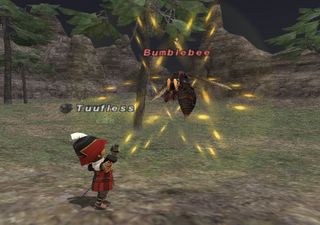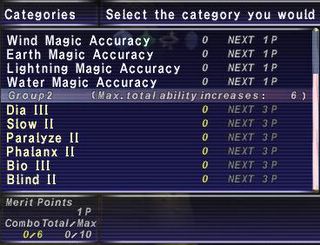Admittedly, that choice was partially inspired by Avesta, and the role that Bind plays in determining the outcome of the fight. One of his more recent accomplishments (which I also find the most impressive) is solo'ing Charybdis around his spawn area. To do so, he used an all-out DEF build with RDM/BLU (for Cocoon) in combination with Gravity, Bind, and the almighty DOT.
Anyway, after some merit parties, a solo session, and an ENM later, I finally raked u p the 30,000 limit points I needed to put a single point into my first "Group 2 spell"- Paralyze II.
There is already a thread trying to decipher some of the mechanics, including Slow II, so I chose to focus on trying to figure out what the deal with Paralyze II is. To that end, I went out to East Sarutabaruta, picked an unfortunate Bumblebee to play with, and started.

Here's how the experiment went. I took four batches of results, each batch containing 100 attempted attacks from a Bumblebee with a Paralyze effect on. First, I took results with Paralyze I and 62 MND (base RDM75 MND for a Taru). My second batch also used Paralyze I, but this time I equipped +32MND worth of gear, for 94MND total.
My third and fourth batches involved the same deal with MND, but I exchanged Paralyze for Paralyze II. Here are the results:
Batch 1: Paralyze I, 62MND
Paralyzed Attacks: 24/100 = 24%
Paralyze Duration (# of attacks): 16, 17, 18, 13, 11, 7, 12
Average Paralyze Duration: 13.43 attacks
Batch 2: Paralyze I, 94MND
Paralyzed Attacks: 19/100 = 19%
Paralyze Duration (# of attacks): 12, 11, 9, 14, 15, 18, 7
Average Paralyze Duration: 12.29 attacks
Batch 3: Paralyze II, 62MND
Paralyzed Attacks: 28/100 = 28%
Paralyze Duration (# of attacks): 11, 8, 10, 12, 11, 7, 13, 20
Average Paralyze Duration: 11.5 attacks
Batch 4: Paralyze II, 94MND
Paralyzed Attacks: 29/100 = 29%
Paralyze Duration (# of attacks): 17, 13, 11, 9, 12, 8, 12
Average Paralyze Duration: 11.71 attacks
*Paralyze Duration does not count the very last Paralyze I cast per batch.
I have to admit, this was fairly discouraging. Against Level 1 Bumblebees, there was nothing significant to say that Paralyze II was any better than Paralyze I. Heck, on average, Paralyze II was wearing off faster than Paralyze I!
Even worse, there isn't much to say about what kind of role MND plays in determining whether the mob skipped its next turn or not. In short, I feel that the sample size is really too small to really draw some conclusions. Granted, MNDs effect would likely be small, and this is really too small a sample size to really draw anything conclusive from.
What I suspect goes on is that MND determines the chance that Paralyze will proc, or more accurately, the difference in your MND, and the mob's MND, similar to how Slow works.
For example, let's say you had a 1000-sided dice. At each attack, the computer rolls that dice. If the number is say, less than 300, then the mob skips its next turn. Adding MND just raises that number to say, 350. If this was the way Paralyze procs are determined, then I may very well have gotten an unlucky streak in Batch 2, which is something a massive volume of data would likely smooth out.
What I can say however, is that because there wasn't any real significant improvement in proc rates when adding on 32MND, it seems that there is a cap to the MND difference, or at least some drastic diminishing returns. Given a Taru's base RDM75 MND is 62, the cap is likely below that. Of course, the problem is then figuring out how to determine whether this postulation is true, but I guess that's what Diorama-Abdhaljs is for.
In any case, some other people have tested more things with Paralyze I, so there's data there to compare with. Their experiment and conclusions is fairly solid, but I dislike how they drew their conclusions based on a range of mobs (T-VT Dhalmels, which would almost certainly give a range of MND stats.) The real question though is how much better a 3rd level Paralyze II is over a plain Paralyze I, but I guess I'll have to repeat this experiment a few (d A brief sample of forum thread topics, taken barely 36 hours after the latest version update includes:
"New Monk Merits -- SHAFTED AGAIN THANKS SE"
"SE Newest Joke: Blu AF1"
"Nin getting screwed even more?"
"Anyone else getting more upset?"
Sometimes, you just can't win. -_-
Granted, not everybody got powerful new abilities to merit, but you'd think people would be looking forward to getting something. -_- In any case, common consensus seems be that THFs, RDMs and BRDs got the goods in this latest version update, which I personally like. Personally, I don't really see how, if this was in an effort to rebalance the jobs, BRD got even more things to add to their repertoire, although I can see how THFs and RDMs needed a little bit of help, even if all RDMs got was the long-overdue reinforcement that they are indeed, the masters of Enfeebling magic.

Now that's an interesting dilemma.
Like many other RDMs and THFs, the question was "What do you merit"? To that end, (and also to straighten my thoughts on this), I suppose I might as well put down my thoughts and impressions to paper (or whatever the digital equivalent would be here).
So far, people appear happy with the tier-II enfeebles. If anything, it solidifies RDM's place as "The Enfeebling class", which until now was suspect because the Ninja's equivalents to Slow, Paralyze and Blind (Hojo, Jubaku and Kurayami) overwrote the RDM's versions. Slow II and Paralyze II, even at their first tier, are slightly more potent than their first-tier versions, and with the ability to further enhance their potency through additional merit upgrades, I'm happy with this move.
Unfortunately, Dia III and Bio III turned out to be rather disappointing, due to their short, 30-second duration at level 1. Granted, additional upgrades increase that period longer, but that doesn't feel like it's worth the opportunity cost, looking at the tier-II enfeebles. Not only that, but the mana cost is high enough such that continuous recast to keep Dia/Bio III on the mob isn't particularly friendly on the mana pool. That all being said, maxing out Bio III as a counter against some HNMs' very damaging attacks seems like a viable option to pursue.
Phalanx II is nice, particularly since it can be cast on other party members. I can't quite comment on its use in HNM, but in terms of xp, I can't help but feel that it would've been much better as a RDM55 spell (possibly a little later, around RDM60 or 65). Nowadays with the trend towards TP spam parties, there isn't a "tank" member per se, and the Phalanx effect would've been very nice for the earlier levels where there is a tank class, a PLD, who could really benefit from it.
It would also give parties more things to consider when it comes to choosing between a RDM or a BRD (although ideally both -_-), which I felt was rather needed, especially post-55, after BRDs learn Ballad II. I found that most people just invited either job for Refresh/Ballad, and not really for what else the job could bring to the table. For example, as it stands, you would want to couple a BLU and RDM together, since a BLU needs the mana refresh, but is stuck in the front lines where a BRD would give him Minuet and Madrigal instead. I didn't feel as if Haste really separated a RDM55+ and BRD55+, given that Bards could just sing March. Having Phalanx II as a RDM55+ spell would force people to think about the tradeoff (Haste + Phalanx II versus Minuet + Madrigal) rather than simply inviting "the Refresh job".
On the HNM side, the structure of the Group II merits lead to some interesting structural considerations. Currently, with just six upgades total, a RDM75 can choose to simply put one point into each new spell, giving him versatility. However, in a team environment, it may be better to instead have the mages divide their merit abilities so the team gets the maximum benefit out of the RDM's enfeebles. That is, have one RDM max out Slow II, another max out Paralyze II, and so on. Given that the current cap stands at 3 upgrades per spell, an HNMLS would just need three RDMs to work with one another and split the six spells amongst them.
This is particularly enticing due to the fact that each spell gets more potent with each upgrade, so with a full arsenal of capped enfeebles between the linkshell's main RDMs, come battle time, the linkshell reaps the benefit of full-powered enfeebles (and Phalanx), as opposed to weaker, half-assed versions.
That idea may be a little extreme, and I don't know if there are any other jobs whose merits allow for this sort of division, but it'd be interesting to see how many (if any) HNMLSes take that extra step to enhance their linkshell's performance. Admittedly, it's not really for the faint hearted, but I can see some of the more hardcore linkshells, like TeamKanican or LimitBreak take a look at this approach.
On the whole, it looks like the new meits can be viewed as a way for SE to encourage players to individualise, although whether this does not buckle down under social pressure once an accepted "best setup" becomes commonplace is yet unknown. Given the nature of the RDM merits, I don't think such an end will come, although I can't really speak for the other jobs. The merits feel more of a minor tweak to the jobs, which I suppose it is good since players won't be shunned for meriting a different spell. However, should such merits matter, how do you distinguish between someone who has leveled up that ability and someone who hasn't, other than word of mouth? Rummaging through search comments ceratinly isn't the most effective way of doing it...

1 comment:
well so far on the BRD front the 1st level of of Troubadour does not increase the potency for Ballad, but sinply the length of time it is on the party members.
So to better explain, Troubadour is like having a instrument that is Ballad+1 (which can only be sung once every 20 mins).
Post a Comment